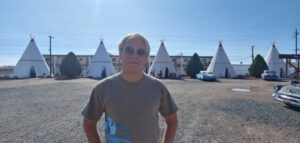Drew Hayden Taylor’s new television series premieres this weekend

By Rick Garrick
CURVE LAKE — Curve Lake writer Drew Hayden Taylor enjoyed capturing stories of Indigenous peoples from across Turtle Island for the first season of his Going Native television series, which premieres on APTN May 8.
“Luckily, we got almost all of the shooting done by the start of the COVID-19 (coronavirus disease 2019 pandemic), so we spent most of last spring and summer doing post-production,” Taylor says. “From the summer before and during the fall and winter, we went all across Canada and down to Arizona, New Mexico, Oregon, and Washington State, going to 20 or 30 First Nation communities and interviewing interesting people and going to interesting places and filming interesting things.”
Taylor says one of the places they visited was Mesa Verde, where the Anasazi built cliff dwellings in the American Southwest.
“[They] disappeared around 1200 AD but their cliff dwellings are still up and still intact,” Taylor says. “We were given a special tour that very few people ever get where we got to see behind the front of the buildings — we got to see pictographs and religious imagery that not everybody gets to see. It was absolutely fascinating, the landscape is wonderful.”
Taylor says they also visited the Yakima people in Oregon while they were fishing with hand-held nets on long poles for salmon that were swimming upstream.
“[They were] standing over this chasm as the salmon swim their way up,” Taylor says. “It was absolutely awe-inspiring.”
Taylor says they also checked out Indian relay racing in southern Alberta, which involves bareback riders racing around the track three times, jumping onto a different horse for each lap.
“It’s absolutely breathtaking and insanely fast,” Taylor says.
Taylor says they also spoke with architects in the United States and Canada about using traditional Indigenous concepts and designs and refocusing them into the modern world and incorporating them into modern-day construction.
“And of course one of my favourites, we did two of them, one was on pop culture where we explored the fondness for zombies in [Indigenous] culture — it was actually quite fun and bizarre,” Taylor says. “And of course, my favourite episode was the gourmet one where we talked to Indigenous cooks all across Canada about again how they incorporate traditional Indigenous foods for a contemporary lifestyle.”
Taylor says they also looked at companion planting at a community garden in Toronto.
“There’s a chef there who puts [in] a lot of his own herbs and food there and he talked about how the Haudenosaunee used to grow the Three Sisters,” Taylor says. “You had the corn growing up towards the sky, the beans would crawl up the corn, and the squash would anchor the corn.”
Taylor says they had the go-ahead for season two of the series for six months but have not been able to do much filming due to the pandemic.
“We’ve done an amazing amount of research, we kind of know the directions we want to go and the people we want to talk to but we’re just waiting for the opportunity to go out and do it,” Taylor says. “So we decided to begin with some stories in southern Manitoba and see how that felt and see if we could do it safely, and we did.”
Taylor says his goal for Going Native and documentaries such as Cottagers and Indians is to shed light on things that are important to Indigenous people.
“What we try and do with these documentaries is try to present a window through which the dominant culture can sort of look and be amazed and be fascinated and embrace the many facets of Indigenous culture, the wonderful, the positive, the empowering things we do,” Taylor says.


